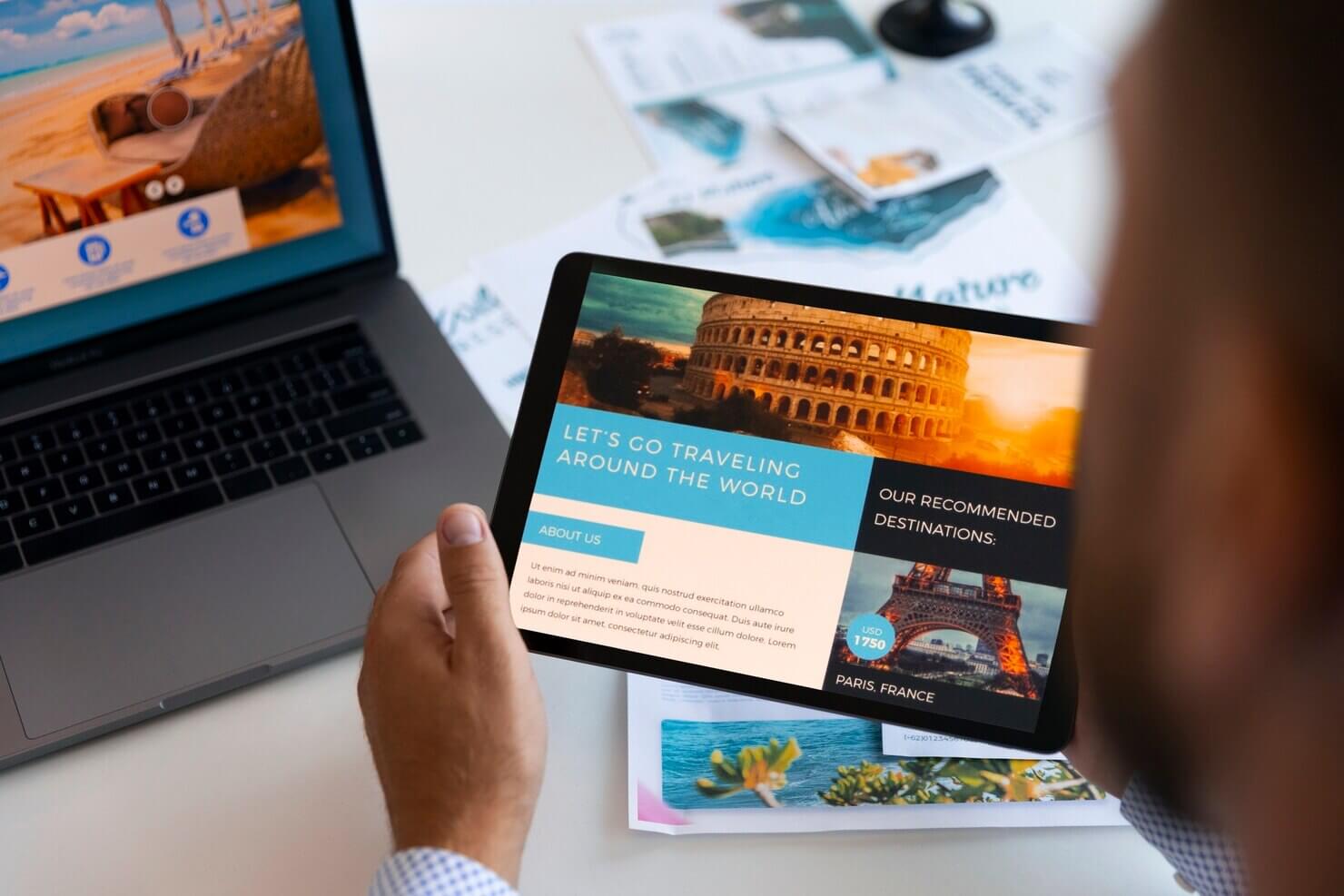Unlock the secrets to crafting a visually captivating travel website using WordPress’s versatile tools and themes. From breathtaking imagery to seamless navigation, learn how to mesmerize your audience and inspire wanderlust with every click.

- Selecting the Perfect WordPress Theme for Your Travel Website
- Essential Plugins to Enhance Your Travel Website's Functionality
- Crafting Engaging Content: Tips for Travel Bloggers
- Optimizing Your Travel Website for Search Engines
- Integrating Social Media to Boost Your Travel Website's Visibility
- Analyzing Your Travel Website's Performance: Tools and Tips
- Frequently Asked Questions
- Dreaming of a travel website that wows?
In the wake of the recent surge in digital nomadism, creating an engaging and visually appealing travel website has never been more crucial. WordPress, with its user-friendly interface and extensive customization options, stands as the ideal platform for aspiring travel bloggers and agencies aiming to captivate their audience. This article delves into the essentials of building a stunning travel website, from selecting themes that resonate with your travel ethos to leveraging plugins that enhance site functionality and crafting content that engages and inspires wanderlust.
Furthermore, we’ll explore strategies for optimizing your site for search engines, integrating social media to widen your reach, and employing analytical tools to monitor and refine your website’s performance. With a focus on practical advice and industry insights, this guide aims to equip you with the knowledge to create a travel website that not only tells a compelling story but also ranks well in search results, ensuring your adventures capture the attention they deserve.
Selecting the Perfect WordPress Theme for Your Travel Website
Choosing the right WordPress theme for your travel website is a pivotal decision that can significantly impact your site’s success. The theme is not only the aesthetic appeal of your website but also its functionality and user experience. It’s essential to opt for a responsive theme, ensuring that your site looks impeccable on all devices, from desktops to smartphones. Additionally, a theme that offers customization flexibility is invaluable, as it allows you to tailor your site to reflect your unique brand and cater to your target audience effectively.
When delving into the vast array of WordPress themes, it’s crucial to consider features that are specifically beneficial for travel websites. Themes that support high-quality visuals are paramount, as captivating imagery is the cornerstone of any travel-related online presence. Look for themes that facilitate easy integration with social media and travel booking systems, enhancing your site’s functionality and user engagement. Moreover, themes with built-in SEO optimization features can give your website a competitive edge, making it more visible to potential visitors through search engines. Selecting a theme that aligns with these criteria can set the foundation for a successful and stunning travel website.
Essential Plugins to Enhance Your Travel Website’s Functionality
Creating a travel website with WordPress offers an array of opportunities to enhance user experience and functionality. To truly elevate your site, incorporating specific plugins designed for travel websites is crucial. These tools can significantly improve aspects such as booking systems, interactive maps, and customer reviews. By selecting the right plugins, you ensure not only a smoother operation of your site but also a more engaging and user-friendly experience for your visitors.
For those looking to optimize their travel website, consider the following essential plugins:
- WP Travel – Ideal for managing travel and tour packages. It allows users to easily book trips, while site owners can customize offerings and manage bookings with ease.
- Traveler – A comprehensive booking plugin that supports a wide range of services including hotels, flights, cars, and tours. Its flexibility and powerful features make it a top choice for travel site owners aiming for a high level of customization and control.
- Yoast SEO – While not travel-specific, optimizing your website for search engines is critical. Yoast SEO helps improve your site’s visibility, driving more traffic, and ensuring your travel content reaches a wider audience.
Integrating these plugins into your WordPress travel site can transform it from a basic blog to a dynamic travel portal offering a wealth of information and services to your visitors. Remember, the goal is to make your website as informative, navigable, and engaging as possible. With the right tools at your disposal, you can enhance your site’s functionality, improve user experience, and ultimately, boost your online presence in the competitive travel industry.

Crafting Engaging Content: Tips for Travel Bloggers
Engaging with your audience by creating captivating content is paramount in the competitive realm of travel blogging. The key to success lies in the ability to tell compelling stories and provide valuable information that resonates with your readers. Here are some strategies to enhance your content creation process:
- Identify Your Unique Angle: Every destination has its stories, but how you tell these stories makes all the difference. Find a unique perspective or niche that sets your content apart from others.
- Utilize High-Quality Images and Videos: Visuals are incredibly powerful in travel blogging. They not only complement your narratives but also engage readers and encourage them to explore further.
- Incorporate SEO Best Practices: Understanding and implementing SEO strategies will help your content reach a wider audience. Use relevant keywords, meta descriptions, and alt text for images to improve your site’s visibility.
- Engage with Your Audience: Encourage readers to interact with your content through comments, social media shares, and feedback. This not only builds a community around your blog but also provides insights into your audience’s preferences.
Optimizing Your Travel Website for Search Engines
Ensuring your travel website ranks highly on search engines is paramount for driving traffic and increasing visibility. Keyword research is the cornerstone of SEO strategy, allowing you to understand what potential travelers are searching for. Incorporating these keywords naturally into your content, titles, and meta descriptions can significantly boost your site’s relevance. Moreover, optimizing images by compressing them and using descriptive file names enhances page load speed and accessibility, further improving SEO. Remember, a fast-loading website not only ranks better but also provides a better user experience.
Additionally, leveraging backlinks from reputable sites within the travel industry can increase your site’s authority and search engine ranking. Undefined elements, such as broken links or missing alt text, should be addressed promptly. In order to avoid negatively impacting your SEO efforts.
Integrating Social Media to Boost Your Travel Website’s Visibility
Maximizing your travel website’s exposure requires a strategic approach to social media integration. Experts advise leveraging platforms where your target audience is most active to share captivating content, travel stories, and exclusive deals. Implementing social sharing buttons directly on your site not only facilitates this but also enhances user engagement and content virality. Additionally, utilizing user-generated content, such as travel photos or testimonials shared by your audience, can significantly boost credibility and attract more visitors. Remember, consistency in your social media presence, coupled with authentic and interactive content, is key to driving traffic. Thus elevating your travel website’s visibility.
Do you want to check the health of your website?

Analyzing Your Travel Website’s Performance: Tools and Tips
Understanding the intricacies of your travel website’s performance is pivotal for its success. Leveraging the right analytical tools can provide invaluable insights into user behavior, traffic sources, and engagement metrics. Google Analytics stands out as a comprehensive solution, offering detailed reports that help optimize your site for better user experience and higher conversion rates.
A noteworthy case study is that of a renowned travel blog that witnessed a 40% increase in user engagement after implementing targeted improvements based on analytics data. This emphasizes the importance of not only collecting data but also applying the insights to make informed decisions. Additionally, tools like Hotjar can offer visual insights through heatmaps and user recordings, revealing how visitors interact with your website. By combining these tools and continuously refining your strategy based on data-driven insights, you can significantly enhance your website’s performance and user satisfaction.
Frequently Asked Questions

How can I ensure my travel website is mobile-friendly?
Ensuring your travel website is mobile-friendly involves selecting a responsive WordPress theme that automatically adjusts its layout across different devices. Additionally, you can use mobile-specific plugins and regularly test your site’s performance on various mobile devices to guarantee a seamless user experience.
What are the best practices for securing my travel website?
Best practices for securing your travel website include regularly updating your WordPress core, themes, and plugins to their latest versions. Implementing strong passwords, using security plugins to monitor and protect your site from threats, and setting up a secure hosting environment are also crucial steps. You can also opt for WordPress support services to give yourself peace of mind while ensuring your site remains in tip-top shape.
How often should I update my travel website’s content?
Updating your travel website’s content regularly is key to keeping your audience engaged and improving your SEO rankings. Aim to post new content at least once a week. However, the frequency can vary based on your schedule and the nature of your travel experiences.
Can I monetize my travel website? If so, how?
Yes, you can monetize your travel website through various methods. Methods such as affiliate marketing, selling digital products or services, displaying ads, and sponsored content. Choosing the right strategy depends on your audience and the type of content you produce.
What is the best way to handle user comments and feedback on my travel website?
Handling user comments and feedback effectively involves actively monitoring your comments section and social media platforms. Respond promptly and professionally to both positive and negative feedback. Consider using plugins that help manage spam and encourage constructive discussions to maintain a positive community atmosphere.
Dreaming of a travel website that wows?
Don’t settle for the ordinary when you can have the extraordinary! Harness the expertise of our WordPress developers to transform your travel website into a stunning digital destination. Drop us a line and let’s make magic happen!
Comments